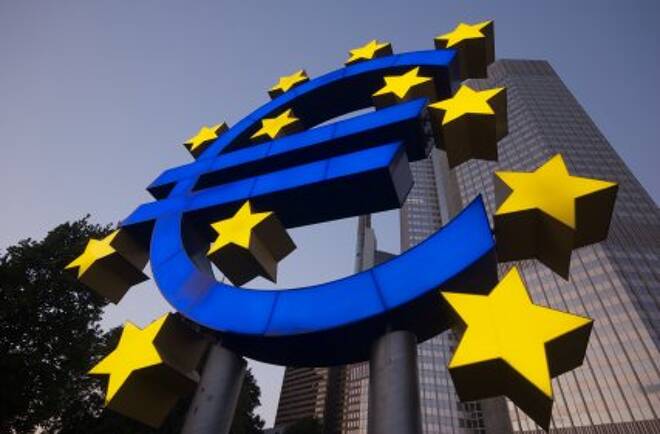Advertisement
Advertisement
EUR/USD Daily Technical Analysis for April 28, 2017
By:
The EUR/USD consolidated on Thursday following the ECB meeting were rates were kept unchanged as expected. Mario Draghi kept a dovish tone, but has left
The EUR/USD consolidated on Thursday following the ECB meeting were rates were kept unchanged as expected. Mario Draghi kept a dovish tone, but has left the door open for a change to QE at the June meeting. Inflation in both Germany and Spain was stronger than expected, while confidence rose showing sentiment is positive in the Eurozone.
Technicals
The EUR/USD consolidated and continues to form a bull flag pattern which is a pause that refreshes higher. Support is seen near a downward sloping trend line that connects the higher in November to the highs in March and comes in near 1.0820. Additional support is seen near the 10-day moving average at 1.0771. Resistance is seen near the April highs at 1.0950. Momentum on the currency pair is positive, but the trajectory of the MACD histogram is trending lower, which could lead to further consolidation. The RSI (relative strength index) moved lower with price action, unable to breach resistance, which also reflects some consolidation.
ECB Keeps Rates Unchanged
The ECB kept interest rates unchanged as expected. Draghi said that QE to run until ECB sees sustained inflation pick up. As expected Draghi acknowledge the improved growth outlook saying downside risks have diminished further, but at the same time he stressed that the very substantial degree of monetary accommodation is still needed and that the ECB needs to see through transient inflation developments. Against the background, Draghi stressed that QE can still be extended or expanded. Draghi focused on energy and food prices in explaining the drop back in March headline HICP and left out the Easter effect, which already saw Spanish and German headline rates jumping higher again, which is likely to be followed by a similar jump in the Eurozone rate.
German Inflation Jumps Back to 2%
German HICP inflation jumps back to 2.0%, from 1.5% year over year in March and a tad above expectations. The Easter effect, which drove up holiday related prices in April rather than in March underpinned the volatility over the March/April period and is largely to blame for the bounce back. Things should normalize again in May, but the numbers nevertheless confirm that inflation is trending higher, with PMI surveys also suggesting that underlying inflation pressures are starting to make a comeback as labor market tightening. Nothing to worry about so far, but the ECB clearly risks falling behind the curve if it doesn’t finally drop the easing bias in June.
Eurozone Economic Confidence Jumped Higher
Eurozone economic confidence jumped to 109.6, from 108.0 in the previous month. A much stronger number than anticipated, with industrial confidence rising to 2.6 from 1.3, consumer confidence confirmed at -3.6 and services confidence rising to 14.2 from 12.8. Very strong numbers, which tie in with the PMIs for April and confirm that the Eurozone recovery is on track.
Spanish Inflation Surged
Spanish HICP inflation surged to 2.6% year over year, from 2.1% year over year in the previous month. We had been expecting a bounce back to 2.4% after the dip in March, and while this was already below consensus, it turned out to be too low. The Easter effect, which meant holiday related prices rose in April, rather than March as in 2016, had a bigger impact than anticipated, although the effect may be exaggerated in Spain, as Easter tourism on the Spanish islands boomed with the tensions in Turkey and other traditional Easter holiday destinations propping up bookings elsewhere. The German state data from Saxony also showed the Easter effect, although the bounce back in the national rate to 2.1% from 1.8% in March, was less pronounced than in Spain. Still, what is clear is that the drop back in Eurozone headline as well as core inflation last month was to a large extend due to special factors and that we will see a reversal with the April numbers, which will add to the arguments of the hawks at the council.
German Consumer Confidence Rose
German May consumer confidence surges to 10.2, from 9.8 in the previous month. Expectations had been for a slight rise to 9.9, so the reading is much stronger than expected. The full breakdown, which is only available until April, when the headline rate fell back slightly, showed business as well as income expectations risingly sharply in line with the willingness to buy. The willingness to save meanwhile dropped further into negative territory. A very strong reading then that backs hopes that consumption will continue to underpin overall growth as net exports continue to detract.
About the Author
David Beckerauthor
David Becker focuses his attention on various consulting and portfolio management activities at Fortuity LLC, where he currently provides oversight for a multimillion-dollar portfolio consisting of commodities, debt, equities, real estate, and more.
Did you find this article useful?
Latest news and analysis
Advertisement
